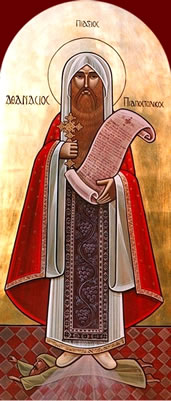Varying accounts of the Melitian Schism (333-335 AD)
A number of various accounts of the Melitian controversy have been preserved, such as those found in the books of notable early church historians (i.e. Sozomen, Socrates, and Theodoret) as well as Athanasius’ own account in his Apologia. Unfortunately, discrepencies in the order of events, as well as the ommission of certain details, can cause confusion when consulting these sources. The following table provides summaries for four of the main accounts of the period from roughly 333-335 AD.
| Athanasius (Ap. 65, 71) | Constantine wrote to Dalmatius, censor living in Antioch, to investigate the murder charges. Dalmatius wrote to Athanasius to prepare his defense. Athanasius sent a deacon to search for Arsenius, who was discovered in Egypt, then in Tyre, where he was convicted before the bishop Paul. Athanasius notified Constantine of the discovery. Constantine then condemned the proceedings and called off the court at Antioch. Eusebius and his followers, who had been coming from the East to appear against Athanasius, were ordered to return. The Melitians were quite for a time after this, but the Eusebians stirred them up again. They persuaded Constantine to hold a new council at Tyre. Athanasius was ordered to attend. |
| Sozomen (HE 2.23, 25.1-2) | After being charged with murder, Athanasius sent a deacon to search for Arsenius, who was discovered to be alive. Athanasius notified Constantine, who then wrote back to him (Ath. Ap. 68). The Melitians were quiet for a while, and Egypt enjoyed a time of relative peace. Athanasius’ enemies renewed the charges, and Constantine ordered a council to assemble at Caesarea in Palestine. Athanasius refused to attend the council for thirty months.* At the end of this interval, he was forced more urgently to go to Tyre, where the Eastern bishops were going to look into the charges made against him.
*It has been established that the Council of Caesarea took place in 334 and the Council of Tyre was in 335. In regards to this “thirty months,” H. Bell suggests that it is either a corruption in the text, or Sozomen is dating from the trial at Antioch, placing it in 333. (Jews and Christians in Egypt: The Jewish Troubles in Alexandria and the Athanasian Controversy, (Oxford: Oxford University Press, 1924), 48). |
| Socrates (HE 1.27.18-21, 28-29) | Dalmatius was to hold court against Athanasius to look into the murder charges. Athanasius searched for Arsenius. He discovered that he was in hiding in Egypt, but was unable to apprehend him because he was constantly moving around. Socrates seems to imply that Constantine suspended the trial because it would be more convenient to hold a council at Tyre, where they would discuss the charges against Athanasius before heading over to Jerusalem for the consecration of a new church. Constantine wrote to Athanasius that if he did not attend the council at Tyre willingly, he would be sent by force. Arsenius was found in concealment in Tyre, apprehended then identified by Paul, Bishop of Tyre. His captors notified Athanasius that Arsenius was alive. Shortly after this was when Athanasius had been summoned to Tyre, where he revealed Arsenius. |
| Theodoret (HE 1.28.2-4, 29, 30.1-8) | Athanasius’ accusers persuaded Constantine to hold a council at Caesarea. Theodosius states that the emperor was completely unaware of the plot the accusers had laid against Athanasius. Athanasius refused to attend, and an angry Constantine wrote to him, ordering him to go to Tyre, where a new council would be held. Theodosius thinks the location was changed because Athanasius did not trust the bishop of Caesarea (Eusebius). Constantine wrote a letter of instruction to the council as to how they should go about handling the situation. Meanwhile, Arsenius had been discovered alive in Egypt and again in Tyre, and was revealed in front of the council assembled at Tyre. |
Created by SMT
Last updated: 10-5-11
No Responses yet
